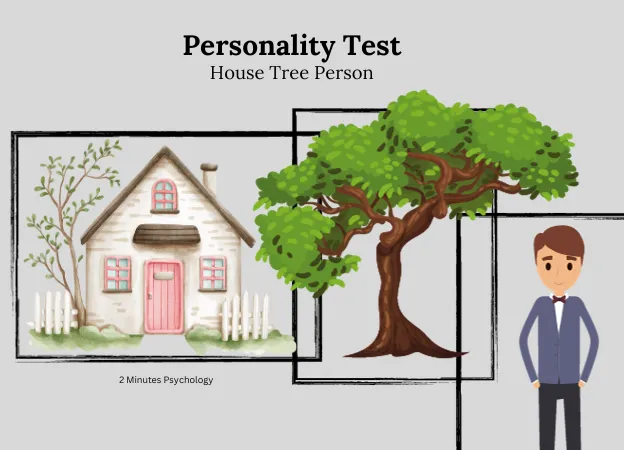The House-Tree-Person (HTP) Test is a renowned projective psychological assessment tool. Traditionally, it's conducted in person, but with advancements in technology, there's growing interest in online versions.

Online House-Tree-Person-Test

2 Minutes Psychology
Sep 10, 2025
The House-Tree-Person Test, often abbreviated as the HTP test, is a distinguished projective psychological evaluation tool, developed by John Buck in 1948. It stands out as a pivotal method for exploring the intricate layers of an individual's subconscious mind, providing profound insights into their emotional states, thought processes, and lived experiences. Unlike other standardized psychological assessments, the HTP test is inherently open-ended, enabling respondents to project their subconscious feelings, thoughts, and experiences onto their responses. This unique characteristic has led to its widespread application in clinical settings to understand an individual's inner worst.
Get your online H-T-P Personality test at Click
Understanding the Process:
The HTP test involves participants drawing three distinct entities: a house, a tree, and a person. Each of these drawings represents different aspects of an individual’s psyche:
House: This drawing is a representation of one’s familial relationships and home environment, offering insights into the individual's familial and personal life.
Tree: This symbolizes the deeper aspects of an individual, including their growth, stability, and emotional well-being.
Person: This reflects the individual’s self-perception and their views on humanity, providing insights into how individuals perceive themselves and others.
Each drawing in the HTP test is a symbolic representation, revealing different facets of an individual's psychological state and emotional well-being. The house represents one's familial relationships and home environment, reflecting the individual's personal life and familial interactions. The tree symbolizes deeper aspects of the individual, including growth, stability, and emotional health, revealing the individual's emotional state and personal development. Lastly, the person drawing reflects the individual's self-perception and their views on humanity, providing insights into how individuals see themselves and others.
Detailed Interpretation:
The interpretation of the HTP test is a complex process that should be undertaken by trained professionals. The focus is on various elements such as the size, placement, and details or omissions in the drawings. For instance, larger drawings may indicate feelings of dominance or a need for attention, while smaller drawings might suggest introversion or insecurity. The presence or absence of specific details, like windows in the house, can also provide significant insights.
Diverse Applications:
The HTP test is versatile, finding applications in various domains, including assessing children's emotional well-being, understanding trauma and significant life events, gaining insights into relationship dynamics, and evaluating psychological disorders. It serves as a valuable tool for psychologists and counselors to explore underlying psychological conditions and emotional states, offering a deeper understanding of an individual's mental health.
Recognizing the Limitations of H-T-P:
While the HTP test offers valuable insights, it is crucial to acknowledge its limitations. Being a subjective test, interpretations can vary widely, and it is essential to use it in conjunction with other assessment tools for a more comprehensive understanding of an individual's psychological state. Cultural and individual differences can also influence the drawings, necessitating consideration of the broader context and background of the individual.
Conclusion:
The House-Tree-Person test is a profound psychological tool that provides a unique window into the human psyche. By analyzing simple drawings, professionals can uncover deep insights into an individual's emotions, experiences, and perceptions. However, it is essential to approach the HTP test with an open mind, empathy, and a deep understanding of its intricacies and limitations, considering its subjective nature and the influence of cultural and individual differences.
Test Instructions:
Participants begin the HTP test by drawing the house, followed by the tree, and finally the person. Each drawing is done on a blank sheet of paper, and a series of questions are asked afterward to gain deeper insights into each drawing. It is crucial to note that this is not a drawing test, and the use of a razor is not allowed. The questions asked are aimed at understanding the individual's thoughts, feelings, and experiences related to each drawing, offering a deeper exploration into their subconscious mind.
Questions to Gain Insight:
After completing the drawings, the examiner asks a series of questions related to each drawing to delve deeper into the individual's subconscious mind. Questions like "Who lives in this house?" for the house drawing, "What kind of tree is this?" for the tree drawing, and "Who is this person?" for the person drawing are common. These questions are designed to explore the individual's thoughts, feelings, and experiences related to each drawing, offering a deeper understanding of their psychological state.
Get your online H-T-P Personality test at Click
Community
Share your experience
Let's Meet 2 Minutes Psychology
Aug 28
Remember
Let's Meet 2 Minutes Psychology
Aug 28
Cognitive Behavioral Therapy (CBT) and anxiety coping skills
Let's Meet 2 Minutes Psychology
Aug 28
Anxiety coping skills for teens
Let's Meet 2 Minutes Psychology
Aug 28
Grounding techniques
Let's Meet 2 Minutes Psychology
Aug 28
Related Posts
Categories
FREQUENTLY ASKED QUESTIONS
House-tree-person-test online?
Who can take the House-Tree-Person test online?
The House-Tree-Person test online, as offered by "2 minutes psychology," is designed to be accessible to a wide range of individuals. Anyone interested in gaining insights into their subconscious feelings, thoughts, and experiences can take the test. Whether you're a student studying psychology, a professional seeking self-awareness, or simply curious about projective psychological tests, "2 minutes psychology" provides an online platform that makes the HTP test easily accessible
Which platforms offer the HTP test online?
2 Minutes Psychology: Known for its quick and accessible psychological tests, this platform provides an online version of the HTP test. They provide a complementary session for free.
.png)

